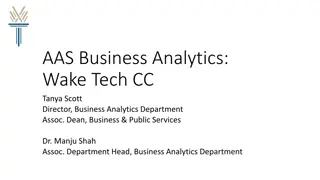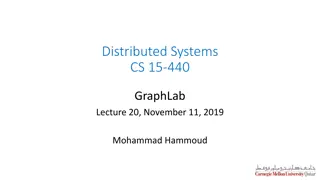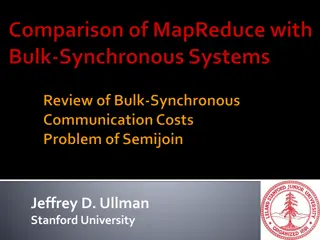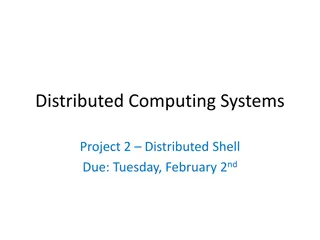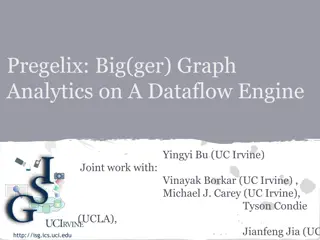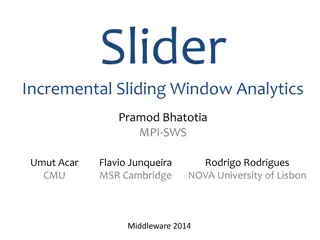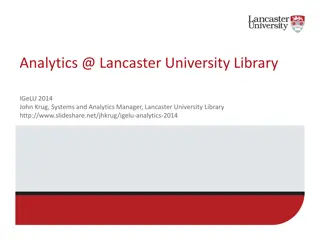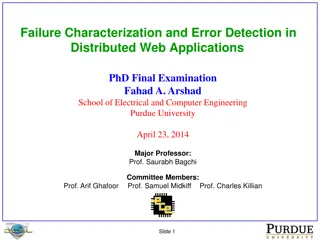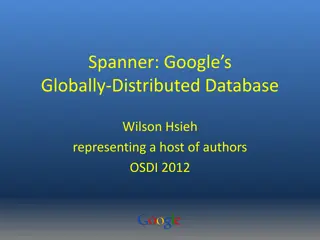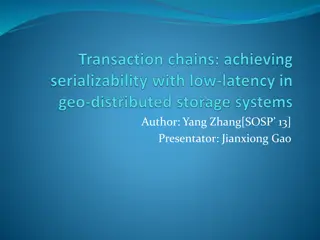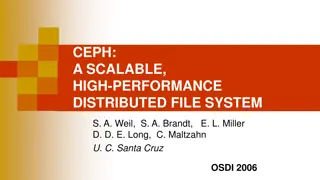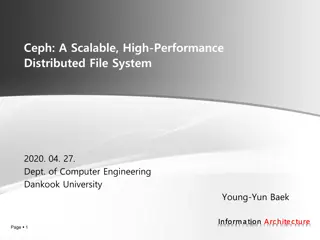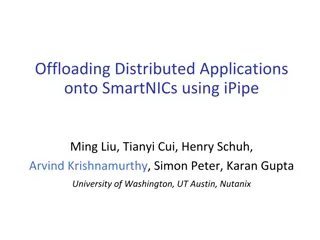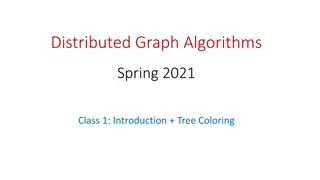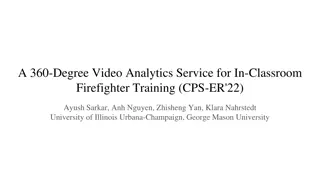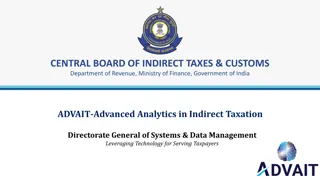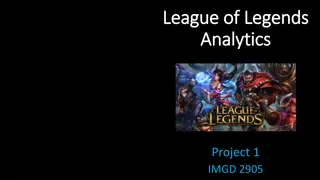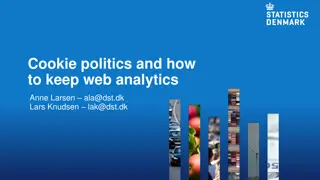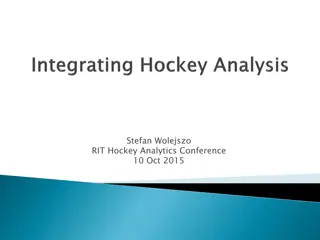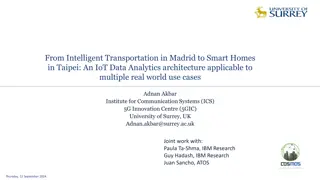Introduction to Google's Pregel Distributed Analytics Framework
Google's Pregel is a large-scale graph-parallel distributed analytics framework designed for graph processing tasks. It offers high scalability, fault tolerance, and flexibility in expressing graph algorithms. Inspired by the Bulk Synchronous Parallel (BSP) model, Pregel operates in super-steps, enabling automatic fault tolerance and efficient message-passing programming. The BSP model, with iterations and barriers, guides the execution flow, making Pregel suitable for a wide range of large-scale applications.
Uploaded on Oct 08, 2024 | 0 Views
Download Presentation

Please find below an Image/Link to download the presentation.
The content on the website is provided AS IS for your information and personal use only. It may not be sold, licensed, or shared on other websites without obtaining consent from the author. Download presentation by click this link. If you encounter any issues during the download, it is possible that the publisher has removed the file from their server.
E N D
Presentation Transcript
Distributed Systems CS 15-440 Pregel & GraphLab Lecture 14, October 30, 2017 Mohammad Hammoud
Today Last Session: Hadoop (Cont d) Today s Session: Pregel & GraphLab Announcements: PS4 is due on Wed November 1st by midnight P3 is due on Nov 12th by midnight
Distributed Analytics Frameworks Pregel Architectural & Scheduling Models Introduction & Execution Model Programming Model
Googles Pregel MapReduce is a good fit for a wide array of large-scale applications but ill-suited for graph processing Pregel is a large-scale graph-parallel distributed analytics framework Some Characteristics: oIn-Memory across iterations (or super-steps) oHigh scalability oAutomatic fault-tolerance oFlexibility in expressing graph algorithms oMessage-Passing programming model oTree-style, master-slave architecture oSynchronous Pregel is inspired by Valiant s Bulk Synchronous Parallel (BSP) model
The BSP Model Iterations Data Data Data Data CPU 1 CPU 1 CPU 1 Data Data Data Data Data Data Data Data CPU 2 CPU 2 CPU 2 Data Data Data Data Data Data Data Data CPU 3 CPU 3 CPU 3 Data Data Data Data Data Data Data Data Barrier Barrier Barrier 5 Super-Step 1 Super-Step 2 Super-Step 3
Googles Pregel: A Birds Eye View The input to Pregel is a directed graph, which can be stored on a distributed storage layer (e.g., GFS or Bigtable) The input graph is partitioned (e.g., using hashpartitioning) and distributed across cluster machines Execution is pursued in super-steps and final output can be stored again in a distributed storage layer HDFS BLK HDFS BLK A Master Machine To HDFS Dataset HDFS BLK HDFS HDFS BLK
Distributed Analytics Frameworks Pregel Architectural & Scheduling Models Introduction & Execution Model Programming Model
Workflow and the Programming Model A user-defined function (sayF) is executed at each vertex (sayV) F can read messages sent to V in super-step S 1and send messages to other vertices, which will receive them at super-step S + 1 Machines F can modify the state of V and its outgoing edges Local Computations Communication Barrier Synchronization F can alter the topology of the graph Vertical Structure of a Super-Step Messages in F are explicitly sent/received by programmers Hence, Pregel employs a message-passing programming model
When Does a Pregel Program Terminate? A Pregel program works as follows: At super-step 0, every vertex is active ONLY active vertices in any super-step perform computations A vertex deactivates itself by voting to halt It, subsequently, enters an inactive state A vertex can return to an active state if it receives an external message Vote to Halt Active Inactive Message Received Vertex State Machine A Pregel program terminates when: All vertices are inactive And, there are no messages in transit
Example: Find Max Value 3 6 2 1 Blue Arrows are messages Blue vertices have voted to halt 3 6 6 6 2 2 1 6 S1 6 6 6 2 6 6 6 S2 6 6 6 6 6 S3
Distributed Analytics Frameworks Pregel Architectural & Scheduling Models Introduction & Execution Model Programming Model
The Architectural and Scheduling Models Pregel assumes a tree-style network topology and a master-slave architecture Core Switch Rack Switch Rack Switch Master Worker4 Worker3 Worker1 Worker5 Worker2 Push work (i.e., partitions) to all workers 12 Send Completion Signals When the master receives the completion signal from every worker in super-step S, it starts super-step S + 1
Googles Pregel: Summary Aspect Google s Pregel Programming Model Message-Passing Execution Model Synchronous Architectural Model Master-Slave Scheduling Model Push-Based Suitable Applications Strongly-Connected Applications
MapReduce vs. Pregel Aspect Hadoop MapReduce Google s Pregel Programming Model Shared-Based Message-Passing Execution Model Synchronous Synchronous Architectural Model Master-Slave Master-Slave Scheduling Model Pull-Based Push-Based Suitable Applications Loosly-Connected Strongly-Connected
The GraphLab Analytics Engine GraphLab The Input, Output & Components The The Motivation & Definition Computation Model Architectural Model Programming Model
Motivation for GraphLab There is an exponential growth in the scale of Machine Learning and Data Mining (MLDM) algorithms Designing, implementing, and testing MLDM at large-scale are challenging due to: Synchronization Deadlocks Scheduling Distributed state management Fault-tolerance The interest on analytics engines that can execute MLDM algorithms automatically and efficiently is increasing MapReduce is inefficient with iterative jobs (common in MLDM algorithms) Pregel cannot run asynchronous problems (common in MLDM algorithms)
What is GraphLab? GraphLab is a large-scale graph-parallel distributed analytics engine Some Characteristics: In-Memory (opposite to MapReduce and similar to Pregel) High scalability Automatic fault-tolerance Flexibility in expressing arbitrary graph algorithms (more flexible than Pregel) Shared-based abstraction (opposite to Pregel but similar to MapReduce) Peer-to-peer architecture (dissimilar to Pregel and MapReduce) Asynchronous (dissimilar to Pregel and MapReduce)
The GraphLab Analytics Engine GraphLab The Input, Output & Components The The Motivation & Definition Computation Model Architectural Model Programming Model
Input, Graph Flow and Output GraphLab assumes problems modeled as graphs It adopts two phases, the initialization and the execution phases GraphLab Execution Phase Initialization Phase (MapReduce) Graph Builder Cluster Distributed File system Distributed File system Distributed File system TCP RPC Comms Parsing + Partitioning Monitoring + Atom Placement Atom Index Atom Index Raw Graph Data Atom File Atom File Atom File Atom File Atom Collection GL Engine Atom File Atom File Atom File Atom File Raw Graph Data GL Engine Atom File Atom File Atom File Atom File GL Engine Index Construction
Components of the GraphLab Engine: The Data-Graph The GraphLab engine incorporates three main parts: 1. The data-graph, which represents the user program state at a cluster machine Vertex Edge Data-Graph
Components of the GraphLab Engine: The Update Function The GraphLab engine incorporates three main parts: 2. The update function, which involves two main sub-functions: 2.1- Altering data within a scope of a vertex 2.2- Scheduling future update functions at neighboring vertices Sv The scope of a vertex v (i.e., Sv) is the data stored in v and in all v s adjacent edges and vertices v
Components of the GraphLab Engine: The Update Function The GraphLab engine incorporates three main parts: 2. The update function, which involves two main sub-functions: 2.1- Altering data within a scope of a vertex 2.2- Scheduling future update functions at neighboring vertices Algorithm: TheGraphLab Execution Engine Schedule v The update function
Components of the GraphLab Engine: The Update Function The GraphLab engine incorporates three main parts: 2. The update function, which involves two main sub-functions: 2.1- Altering data within a scope of a vertex 2.2- Scheduling future update functions at neighboring vertices c c b b d a CPU 1 Scheduler e e f f g a b h i i i j j k h CPU 2 The process repeats until the scheduler is empty
Components of the GraphLab Engine: The Sync Operation The GraphLab engine incorporates three main parts: 2. The sync operation, which maintains global statistics describing data stored in the data- graph Global values maintained by the sync operation can be written by all update functions across the cluster machines The sync operation is similar to Pregel s aggregators A mutual exclusion mechanism is applied by the sync operation to avoid write- write conflicts For scalability reasons, the sync operation is not enabled by default
The GraphLab Analytics Engine GraphLab The Input, Output & Components The The Motivation & Definition Computation Model Architectural Model Programming Model
The Architectural Model GraphLab adopts a peer-to-peer architecture All engine instances are symmetric Engine instances communicate together using Remote Procedure Call (RPC) protocol over TCP/IP The first triggered engine has an additional responsibility of being a monitoring/master engine Advantages: Highly scalable Precludes centralized bottlenecks and single point of failures Main disadvantage: Complexity
The GraphLab Analytics Engine GraphLab The Input, Output & Components The The Motivation & Definition Computation Model Architectural Model Programming Model
The Programming Model GraphLab offers a shared-based programming model It allows scopes to overlap and vertices to read/write from/to their scopes
Consistency Models in GraphLab GraphLab guarantees sequential consistency Provides the same result as a sequential execution of the computational steps User-defined consistency models Full Consistency Vertex Consistency Edge Consistency Full Consistency Edge Consistency Vertex Consistency Vertex v
Consistency Models in GraphLab Read Write Consistency Model Full 1 2 3 4 5 D3 D4 D1 D2 4 5 2 3 D3 D4 D1 D2 D5 Read Write Consistency 1 2 3 4 5 Model Edge D3 D4 D1 D2 4 5 2 3 D3 D4 D1 D2 D5 Read Write Consistency 1 2 3 4 5 Vertex Model D3 D4 D1 D2 4 5 2 3 D3 D4 D1 D2 D5
The GraphLab Analytics Engine GraphLab The Input, Output & Components The The Motivation & Definition Computation Model Architectural Model Programming Model
The Computation Model GraphLab employs an asynchronous computation model It suggests two asynchronous engines Chromatic Engine Locking Engine The chromatic engine executes vertices partially asynchronous It applies vertex coloring (e.g., no adjacent vertices share the same color) All vertices with the same color are executed before proceeding to a different color The locking engine executes vertices fully asynchronously Data on vertices and edges are susceptible to corruption It applies a permission-based distributed mutual exclusion mechanism to avoid read- write and write-write hazards
How Does GraphLab Compare to MapReduce and Pregel?
GraphLab vs. Pregel vs. MapReduce Aspect Aspect Aspect Aspect Aspect Aspect Hadoop MapReduce Hadoop MapReduce Hadoop MapReduce Hadoop MapReduce Hadoop MapReduce Hadoop MapReduce Pregel Pregel Pregel Pregel Pregel Pregel GraphLab GraphLab GraphLab GraphLab GraphLab GraphLab Programming Model Programming Model Programming Model Programming Model Programming Model Programming Model Shared-Based Shared-Based Shared-Based Shared-Based Shared-Based Shared-Based Message-Passing Message-Passing Message-Passing Message-Passing Message-Passing Message-Passing Shared-Memory Shared-Memory Shared-Memory Shared-Memory Shared-Memory Shared-Memory Computation Model Computation Model Computation Model Computation Model Computation Model Synchronous Synchronous Synchronous Synchronous Synchronous Synchronous Synchronous Synchronous Synchronous Synchronous Asynchronous Asynchronous Asynchronous Asynchronous Asynchronous Parallelism Model Parallelism Model Parallelism Model Parallelism Model Data-Parallel Data-Parallel Data-Parallel Data-Parallel Graph-Parallel Graph-Parallel Graph-Parallel Graph-Parallel Graph-Parallel Graph-Parallel Graph-Parallel Graph-Parallel Architectural Model Architectural Model Architectural Model Master-Slave Master-Slave Master-Slave Master-Slave Master-Slave Master-Slave Peer-to-Peer Peer-to-Peer Peer-to-Peer Task/Vertex Scheduling Model Scheduling Model Task/Vertex Pull-Based Pull-Based Push-Based Push-Based Push-Based Push-Based Loosely- Application Suitability Strongly-Connected Applications Strongly-Connected Applications (more precisely MLDM apps) Connected/Embarrassing ly Parallel Applications
Next Week Caching
PageRank PageRank is a link analysis algorithm The rank value indicates an importance of a particular web page A hyperlink to a page counts as a vote of support A page that is linked to by many pages with high PageRank receives a high rank itself A PageRank of 0.5 means there is a 50% chance that a person clicking on a random link will be directed to the document with the 0.5 PageRank
PageRank (Contd) Iterate: Where: is the random reset probability L[j] is the number of links on page j 1 2 3 4 5 6
PageRank Example in GraphLab PageRank algorithm is defined as a per-vertex operation working on the scope of the vertex pagerank(i, scope){ // Get Neighborhood data (R[i], Wij, R[j]) scope; // Update the vertex data 1 ( ] [ + i R [ N j ) [ ; ] j W R ji ] i // Reschedule Neighbors if needed if R[i] changes then reschedule_neighbors_of(i); } Dynamic computation


